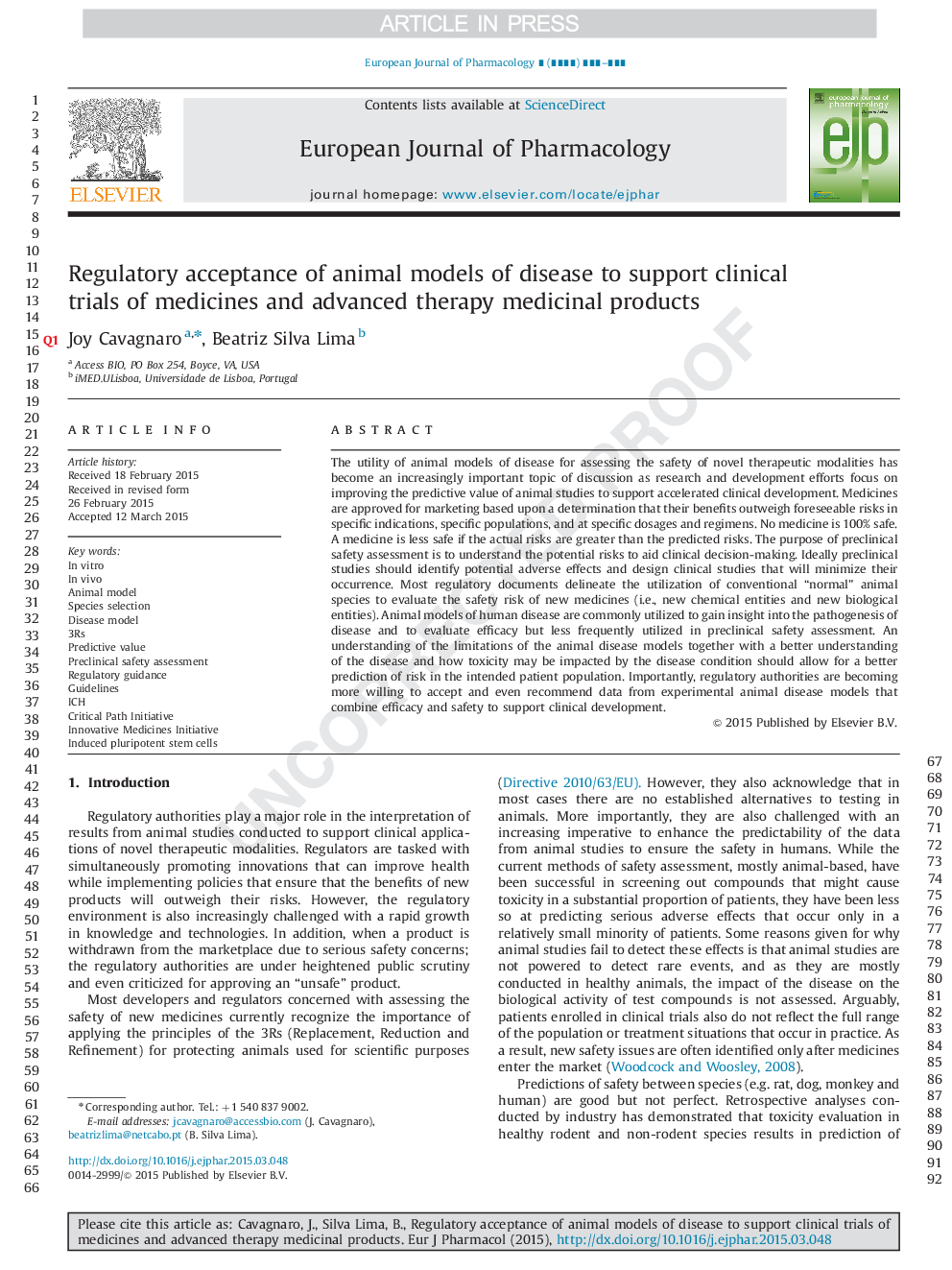| کد مقاله | کد نشریه | سال انتشار | مقاله انگلیسی | نسخه تمام متن |
|---|---|---|---|---|
| 5827269 | 1558922 | 2015 | 12 صفحه PDF | دانلود رایگان |
عنوان انگلیسی مقاله ISI
Regulatory acceptance of animal models of disease to support clinical trials of medicines and advanced therapy medicinal products
ترجمه فارسی عنوان
پذیرش قانونی الگوهای حیوانی بیماری برای حمایت از آزمایشات بالینی داروها و داروهای پیشرفته دارویی
دانلود مقاله + سفارش ترجمه
دانلود مقاله ISI انگلیسی
رایگان برای ایرانیان
کلمات کلیدی
3Rsinnovative medicines initiative - ابتکارات داروهای ابتکاریpredictive value - ارزش پیش بینی کنندهSpecies selection - انتخاب گونهIn vivo - درون تنی یا درونجانداریIn vitro - درونکشتگاهیRegulatory guidance - راهنمایی های مقرراتInduced pluripotent stem cells - سلول های بنیادی پرتوان القاییDisease model - مدل بیماریAnimal model - مدل حیوانیICH - منGuidelines - گایدلاین یا دستورالعمل
ترجمه چکیده
استفاده از مدلهای حیوانی بیماری برای ارزیابی ایمنی روشهای جدید درمان، تبدیل شده است به موضوع به طور فزاینده ای مهم بحث به عنوان تلاش های تحقیق و توسعه تمرکز بر بهبود ارزش پیش بینی مطالعات حیوانات برای حمایت از توسعه بالینی شتاب. داروها برای بازاریابی بر اساس تصمیم گیری که مزایای آنها بیش از خطرهای قابل پیش بینی در نشانه های خاص، جمعیت خاص، و در دوز و رژیم های خاص است، برای بازاریابی تایید شده است. هیچ دارو 100٪ امن نیست. اگر خطرات واقعی بیشتر از خطرات پیش بینی شده است، یک دارو کمتر امن است. هدف از ارزیابی ایمنی پیشین، شناخت خطرات احتمالی برای کمک به تصمیم گیری بالینی است. ایده آل مطالعات پیش از مواجهه باید عوارض جانبی بالقوه را شناسایی و طراحی مطالعات بالینی را انجام دهند تا موجب بروز آنها شوند. اکثر اسناد قانونی استفاده از استاندارد معمولی را مشخص می کند؟ گونه های حیوانی برای ارزیابی خطر ایمنی داروهای جدید (به عنوان مثال، واحدهای شیمیایی جدید و نهادهای جدید بیولوژیکی). مدل های حیوانی از بیماری های انسانی معمولا برای به دست آوردن بینش به پاتوژنز بیماری و ارزیابی اثربخشی استفاده می شود، اما کمتر مورد استفاده در ارزیابی ایمنی قبل از مصرف است. شناخت محدودیت های مدل های بیماری حیوانات همراه با درک بهتر این بیماری و اینکه چگونه احتمال ابتلا به بیماری ممکن است تحت تاثیر بیماری قرار گیرد، باید پیش بینی خوبی از خطر در جمعیت بیمار مورد نظر را داشته باشد. مهمتر از همه، مقامات نظارتی بیشتر مایل به قبول و حتی توصیه داده ها از مدل های بیماری های آزمایشی حیوانات هستند که کارایی و ایمنی را برای حمایت از پیشرفت بالینی ترکیب می کنند.
موضوعات مرتبط
علوم زیستی و بیوفناوری
علم عصب شناسی
علوم اعصاب سلولی و مولکولی
چکیده انگلیسی
The utility of animal models of disease for assessing the safety of novel therapeutic modalities has become an increasingly important topic of discussion as research and development efforts focus on improving the predictive value of animal studies to support accelerated clinical development. Medicines are approved for marketing based upon a determination that their benefits outweigh foreseeable risks in specific indications, specific populations, and at specific dosages and regimens. No medicine is 100% safe. A medicine is less safe if the actual risks are greater than the predicted risks. The purpose of preclinical safety assessment is to understand the potential risks to aid clinical decision-making. Ideally preclinical studies should identify potential adverse effects and design clinical studies that will minimize their occurrence. Most regulatory documents delineate the utilization of conventional “normal” animal species to evaluate the safety risk of new medicines (i.e., new chemical entities and new biological entities). Animal models of human disease are commonly utilized to gain insight into the pathogenesis of disease and to evaluate efficacy but less frequently utilized in preclinical safety assessment. An understanding of the limitations of the animal disease models together with a better understanding of the disease and how toxicity may be impacted by the disease condition should allow for a better prediction of risk in the intended patient population. Importantly, regulatory authorities are becoming more willing to accept and even recommend data from experimental animal disease models that combine efficacy and safety to support clinical development.
ناشر
Database: Elsevier - ScienceDirect (ساینس دایرکت)
Journal: European Journal of Pharmacology - Volume 759, 15 July 2015, Pages 51-62
Journal: European Journal of Pharmacology - Volume 759, 15 July 2015, Pages 51-62
نویسندگان
Joy Cavagnaro, Beatriz Silva Lima,
